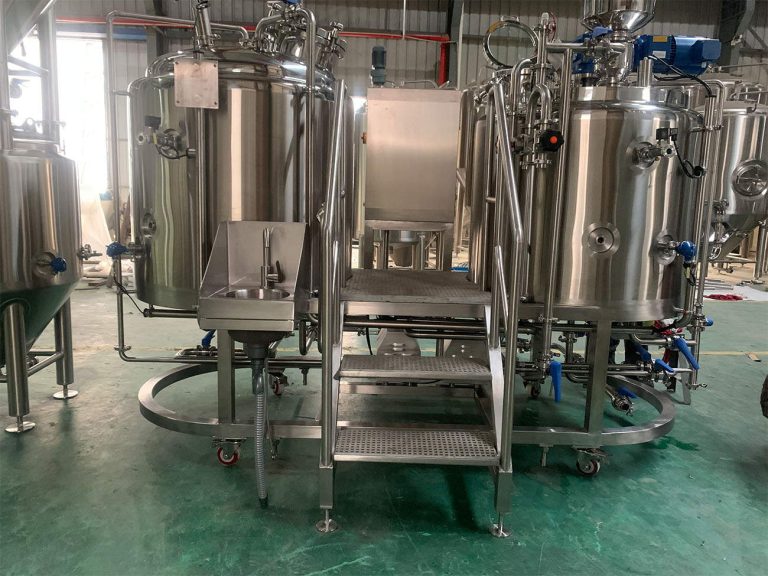

A 500L restaurant beer brewing system refers to a larger brewing setup designed specifically for restaurants, brewpubs, or small-scale commercial brewing operations. This size is suitable for producing larger quantities of beer compared to nano breweries but is still considered on the smaller end of commercial brewing systems.
1.Introduction:
A 500L restaurant beer brewing system refers to a larger brewing setup designed specifically for restaurants, brewpubs, or small-scale commercial brewing operations. This size is suitable for producing larger quantities of beer compared to nano breweries but is still considered on the smaller end of commercial brewing systems.
2.500L restaurant beer brewing system specification:
| Output/Brew | 500L |
| Brew/Week | 2~6 |
| Output/Week | 1000~3000L |
| Electric Supply | 3phase/380(208, 415,480…)v/50 (60)Hz |
| Heating Source | Electric/Steam |
| Area Request | 50m2-70m2 |
| Brewmaster | 1 |
3.500L Nano Brewery System Configuration:
| General specification for 500L brewery equipment | ||||
| No. | Name | Components | Capacity | Specification |
| 1 | Grain Milling Unit | Rolling Miller | 80~150kg/hr | Double roller |
| Power:1.1Kw | ||||
| Noise:45±3db | ||||
| 2 | Brewhouse Unit | Mash/Lauter tun | 500L (total 610L) | Side mounted grain outdoor with grain chute |
| Laser cutting V-wire False Bottom | ||||
| Kettle/Whirlpool Tun | 530L (total 870L) | Electric heating; Power: 27kw | ||
| Tangential whirlpool inlet | ||||
| Sanitary leveling sight glass | ||||
| Heat exchanger | 6M2(Effective area) | Completely 304 SS Corrugated plates | ||
| YUY pump | 3M3 | ABB, Sanitary SUS304, VFD control | ||
| Pipe and fittings | As design | completely SS304 | ||
| 3 | Fermentation unit | Fermenter | 500L or 1000L | Dimple cooling jacket on cone and bottom |
| Top or side manway | ||||
| 60 degree cone bottom | ||||
| Perlick style full sanitary sampling valve | ||||
| Carbonation port and level tube for special request | ||||
| 4 | Bright beer tank | Bright beer tank | 500L or 1000L | Dimple cooling jacket on cone and bottom |
| Level tube for checking | ||||
| Top or side manway | ||||
| Perlick style full sanitary sampling valve | ||||
| Carbonation port with tri clmap carbonation stone | ||||
| 6 | Glycol Chilling Unit | Glycol Water Tank | 1000L | Insulated conical top and sloped bottom |
| Chiller | 5HPx1PCS | Cooling Capacity: 11000Kcal/5HP | ||
| Installed Power:5.5kw | ||||
| Noise:70-80db | ||||
| Refrigerant: Freon R404A ,R410A | ||||
| Coperland compressor | ||||
| PVC pipe | As designed | Solenoid valves for glycol inlet to tanks are included | ||
| Glycol water pump | 3M3 | Sanitary SUS304, VFD control | ||
| 7 | Control unit | Brewhouse and fermentation
process Controlling |
Floor type | Manual button control panel or PLC control with touch screen for special |
| 8 | CIP | CIP pump with VFD | 3M3 | YUY, VFD control |
| 9 | Keg cleaning | 2 head | 20-30kegs/hr | Heating: Electric, Power: 15kw |
| 10 | Keg filling | A coupler | Manual | Coupler for filling beer |
| 11 | Bottling line | 4 head | 160-180 bottles/hr | Manual |
| 12 | Others | Option | Can be Customized | Auger System |
| Grain Case | ||||
| Grist Hydrator | ||||
| Piping flow panel for Brewhouse | ||||
4.Advantages of a 500L nano brewing equipment:
A 500L brewery equipment setup offers several advantages for restaurants or brewpubs looking to brew beer on-site:
Increased Production Capacity: Compared to smaller nano or homebrewing systems, a 500L brewery allows for larger batch sizes, enabling the production of a more significant volume of beer per brewing cycle. This meets the demand of a restaurant or brewpub serving its own beer on-site.
Customization and Variety: With a larger capacity, brewers can produce a wider variety of beer styles and offerings, catering to diverse consumer preferences. This flexibility in production allows for more experimentation and customization of recipes.
Freshness and Local Appeal: Serving freshly brewed beer on-site enhances the freshness of the product, which can be a significant draw for customers. Additionally, emphasizing locally brewed beer can appeal to patrons seeking a more authentic and community-focused experience.
Adaptability and Expansion: A 500L brewery setup provides a good balance between capacity and flexibility. It allows for expansion in the future if the demand for house-brewed beer increases, without the massive scale of larger commercial brewing systems.
5.What factors should be considerations about 500L nano brewing equipment:
When considering a 500L nano brewing system, several crucial factors come into play:
Space Requirements: Larger brewing equipment naturally demands more space. Assess the available area for the brewing setup, including brewing, fermenting, storage, and operational space within your facility.
Budget and Investment: A 500L system is a significant investment. Consider the costs not only for the brewing equipment but also for ingredients, utilities, permits, and ongoing maintenance. Ensure your budget can cover these expenses.
Utilities and Infrastructure: Understand the utility needs such as water, electricity, ventilation, and drainage. A larger system like this demands more resources than smaller setups.
Regulations and Compliance: Compliance with local regulations, licensing, health codes, and safety standards is crucial when operating a commercial brewery. Ensure you understand and meet all legal requirements.
Production Capacity and Demand: Evaluate the market demand for your beer. A 500L system produces a substantial quantity, so you need a market that can absorb that output. Ensure there’s enough demand to justify the production scale.
Quality Control and Consistency: Larger batches present challenges in maintaining consistency and quality. Ensure the system is equipped with features that support quality control throughout the brewing process.
Staffing and Expertise: Assess the expertise needed to operate and manage a larger brewing system. Consider whether your existing staff needs additional training or if you need to hire experienced brewers.
Maintenance and Support: Ensure you have access to reliable support and maintenance for the equipment. Timely servicing and maintenance are crucial to avoid downtime and operational issues.
Maintenance and Support: Ensure you have access to reliable support and maintenance for the equipment. Timely servicing and maintenance are crucial to avoid downtime and operational issues.
Marketing and Distribution: Develop a plan for marketing your beer and distributing it to consumers. Consider whether you’ll sell it primarily on-site or if you’ll distribute it to other locations.
Conclusion:
A 500L restaurant beer brewing system presents a great opportunity for restaurants to offer unique, freshly brewed beer to their customers. However, it requires careful planning, investment, and operational considerations to ensure success.